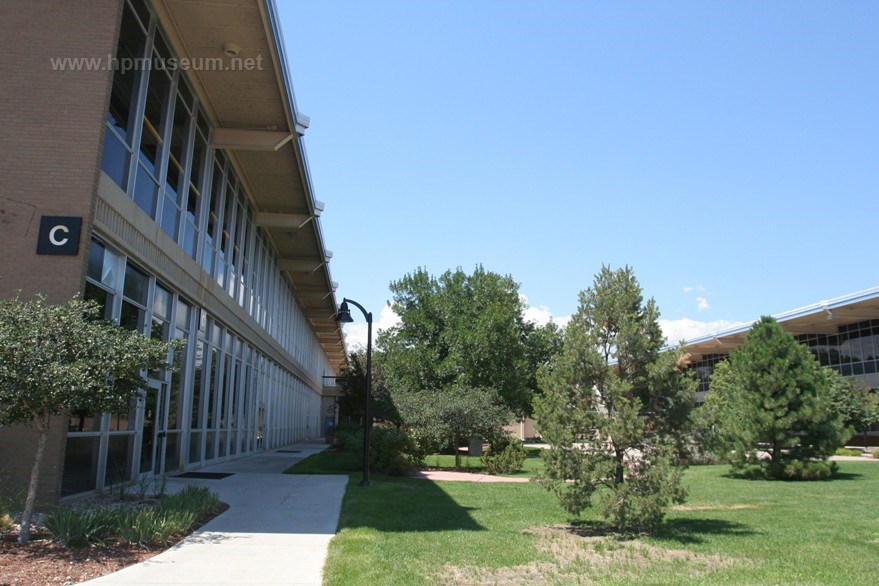Loveland
 | |
| Founded: 1960 | |
| Address: 815 Fourteenth St SW, Loveland, Co | |
| HP Loveland Campus, Building C | |
Description:
Photos contributed by: Ken Jessen.
By the end of the 1950s, HP had become a public company and was looking to expand its manufacturing presence outside of the San Francisco Bay Area. David Packard had a soft spot for his home state of Colorado, and the cities of Boulder and Loveland were considered as sites for HP expansion. HP selected Loveland. Boulder was almost selected, but the two sites HP considered in the area both ended up having significant problems. One of the sites was located over an old coal mine that had been burning for most of the century (and still was burning). The other site was located in a low-lying area. Although HP was assured that the location was not a flood risk, the site was inundated in a flash flood three years later. The city of Loveland had offered to give HP land for its facility, but HP insisted that it didn’t expect something for nothing (Measure, Nov-Dec ’82, page 9) and purchased the site outright. HP became the first large electronics firm to establish a plant in Colorado.
HP started building in Loveland in February of 1960, and the first structure was completed in June of that year. The 12,800 square foot building was located at the corner of Third Street South and Lincoln Avenue. The first general manager of the new division was Stan Selby. The plant employed 28 people when production began in July of 1960. The first products built at Loveland were power supplies, including the 711, 712, 715 and 721. R&D at the division began in March of 1961 in a Lincoln Avenue Quonset hut. HP intended these first two buildings to be temporary. HP completed its first permanent building (Building A) at 815 Fourteenth St NW in October of 1962. At the time of its completion, Building A was the largest single structure in HP.
In 1966, Building B was completed, adding 123,000 square feet to the capacity of the division. In the summer of 1969, HP began construction on Building C. The exterior of the building was completed in 1970. The interior of the building was not finished and Building C was not occupied due to the slowdown in business caused by the recession. After sitting vacant for two years, Building C was occupied in April of 1972.
In March of 1965, Ray Demere replaced Selby as GM of the division. Selby left to become general manager of the new Colorado Springs Division (oscilloscopes). In March of 1970, Marco Negrete succeeded Demere as general manager of the division.
Loveland became involved in the computer business when production of the 9100A commenced in February of 1968. The 9100A was developed at HP Labs in Palo Alto. It was HP’s first desktop computer and created an industry revolution. By the end of the year, the 9100A was one of HP's top four revenue products averaging 200 units per month. Within a year, the new calculator business was as large as HP's 211X minicomputer business. The 9810A was developed at Loveland and introduced in 1971 to replace the 9100B. In 1971, the Loveland Calculator Division introduced HP’s first digitizer, the 9107A. The 9107A was connected to the 9100B calculator. This digitizer would later become the 9864A.
In 1972, the Loveland Division sold HP's 15,000th desktop calculator.
The Loveland Division developed all HP desktop computers until responsibility for the product range was transferred to the new Fort Collins Division in 1977. These desktop computers included the 9820A and 9830A (1972), the 9805A (1973), the 9815A (1975) and the very successful 9825 (1976) and 9845 (1977) computers. The Loveland Division also made or sourced the peripherals that attached to the desktop computers, including HP’s first daisy-wheel printer, the 9871A (1975). While the HP desktop computers were very successful, the bulk of the products that came out of Loveland were instruments, particularly voltmeters.
In November of 1974, HP established the Calculator Group which included Loveland Calculators (managed by Tom Kelley) and the Advanced Products Division. This group was headed by George Newman. Bob Watson replaced George Newman as head of the Calculator Products Group in August of 1976. Don Schultz was appointed general manager of the Loveland Calculator Division (also known as the Calculator Products Division) in September of 1976.
In April of 1976, HP bought a site a few miles from the Loveland Division in Fort Collins as the future home of the desktop computer business (still being called “calculators” at the time). In August of 1978, the Calculator Products Division moved to Fort Collins and was renamed the Desktop Computer Division.
The Loveland site continued to grow rapidly even after the computer operations had transferred out. In 1981, the site employed 3,000 people, five percent of HP's worldwide workforce. That year, the division had turnover of $173M. Voltmeters and Source Analyzers accounted for almost 80 percent of revenue.
Agilent operated the division after the company split with HP in 1998. By 2005, there were only 500 or so employees working at the site. Agilent vacated most of the site in 2007. Agilent employed about 300 people in Loveland when Keysight Technologies was formed in 2014.
“How It All Began, Hewlett-Packard's Loveland Facility” is a detailed history of HP's Loveland Division. The book was written by former HP employee (and great guy) Kenneth Jessen and was published by J.V. Publications. ISBN 1-928656-02-1. (1999).
The Loveland Division began publication of Keyboard Magazine newsletter in 1969.
| Back | More Images |
^ TOP©2004 - 2024 BGImages Australia - All Rights Reserved.
The HP Computer Museum and BGImages Australia are not affiliated with HP Inc. or with Hewlett Packard Enterprise. Hewlett Packard and the HP logo are trademarks of HP Inc and Hewlett Packard Enterprise. This website is intended solely for research and education purposes.
